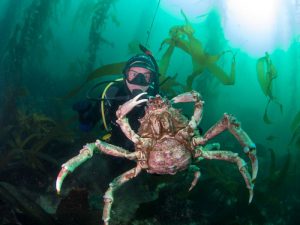

It may be called a sheep crab but it looks nothing like a sheep and it sure doesn’t make a sound like a sheep. So, why are they called sheep crabs? It is reported that the name “sheep” comes from the wool-like algae that covers their exoskeleton.
As juveniles they use barnacles, bryozoans, hydroids, and algae as camouflage by decorating their carapace to protect themselves from predators. However, as adults they no longer do this because they are large enough to protect themselves from predators. The alga that grows on the adult carapace is known as an epibiont, an organism that lives on the surface of another living organism.
 Their scientific name is Loxorhynchus grandis and they can be found as far north as Pt. Reyes, California to Baja California. You can see them if you went snorkeling or while scuba diving, their range in the water is from 20 ft to 500 ft of depth.
Their scientific name is Loxorhynchus grandis and they can be found as far north as Pt. Reyes, California to Baja California. You can see them if you went snorkeling or while scuba diving, their range in the water is from 20 ft to 500 ft of depth.
During the winter they like to spend their time in deep waters. But when the spring rolls around, both females and males travel to shallower waters to mate. The females carry a brood on their underside in the abdomen. The brood can be as low as 150,000 eggs or as much as 500,000 eggs.
 Some species of crabs have the ability to molt their entire lives, they can shed their exoskeleton when they need to grow. The sheep crab can only do this up to a certain point. Once a sheep crab reaches maturity they have a terminal molt. After this final molt they are no longer able to increase in size or generate a limb if it is lost.
Some species of crabs have the ability to molt their entire lives, they can shed their exoskeleton when they need to grow. The sheep crab can only do this up to a certain point. Once a sheep crab reaches maturity they have a terminal molt. After this final molt they are no longer able to increase in size or generate a limb if it is lost.


